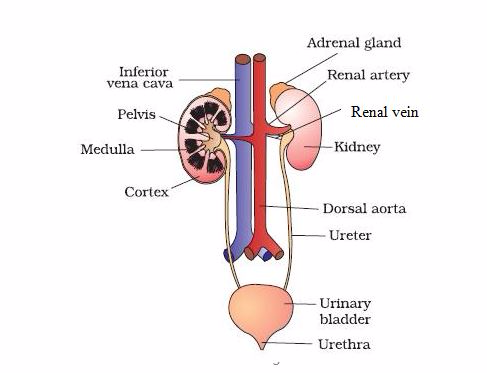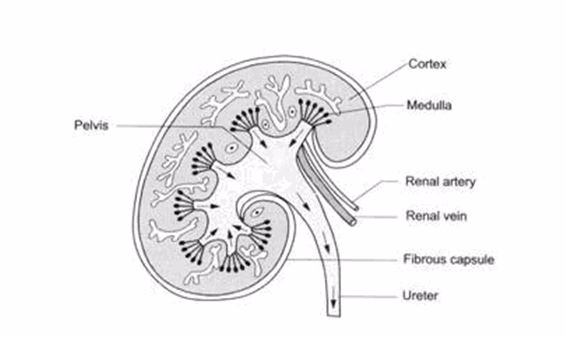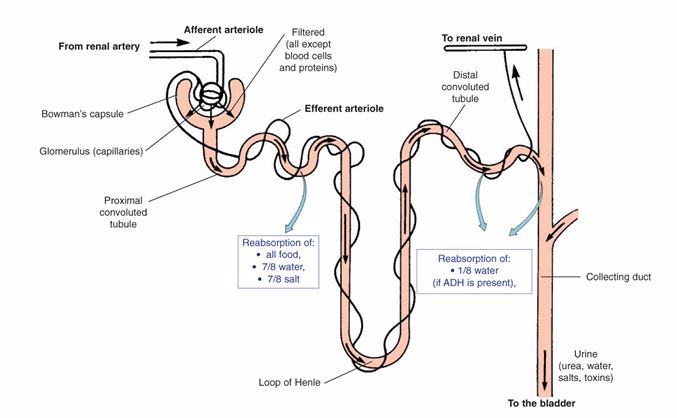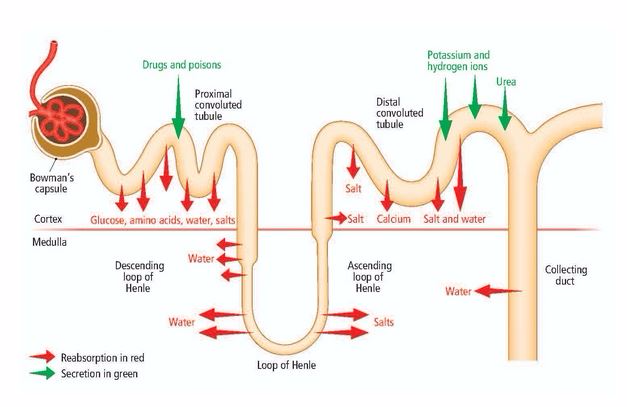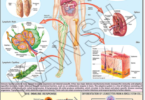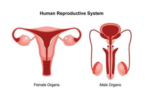TOPIC 4: EXCRETION ~ BIOLOGY FORM 3
EXCRETION
Concept of Excretion
Explain the concept of excretion
Chemical reactions occur in the cells of living organisms all the time to carry out the life processes. The sum of these reactions is called metabolism. Metabolism produces useful products as well as toxic (poisonous) by-products.
These toxic substances have to be removed as they are harmful if allowed to accumulate. The removal of metabolic waste products from the body of an organism is known as excretion.
The major excretory products are carbon dioxide, excess water, and nitrogenous compounds like ammonia, urea, uric acid, etc. Carbon dioxide and water are produced in the process of tissue respiration. Nitrogenous compounds are formed from the breakdown of proteins and amino acids. Water and salts in excess of the body’s needs are also excreted.
Other excretory products include chemicals from medicines, toxic substances, and circulating hormones that have already served their purpose. We will learn how metabolic wastes get eliminated.
In concise, excretion is the process by which waste products of metabolism and other non-useful materials are eliminated from an organism.
Examples of Excretory Products Eliminated by Organisms
Give examples of excretory products eliminated by organisms
Living organisms excrete various excretory products of diverse chemical nature.
The following are examples of excretory products excreted by living organisms:
Excretion in Plants
Types of Excretory Products Eliminated by Plants
Excretion occurs in plants and animals as they both have waste products to be removed from their bodies. Compared to animals, plants do not have a well-developed excretory system to throw out nitrogenous waste materials. This is because of the differences in their physiology. Therefore, plants use different strategies for excretion.
Plants eliminate some waste through diffusion. During the day, excess oxygen gas produced by photosynthesis is released through the stomata. Carbon dioxide produced by respiration is normally used up during photosynthesis.
At night, however, as photosynthesis slows down, carbon dioxide is not used up as fast as it is produced, and it is released as a waste product. Plants also produce oxygen as a by-product of photosynthesis. The oxygen that is not used for respiration is also excreted through the stomata.
Excess water evaporates mostly from stomata and also from the outer surface of the stem, fruits, etc., throughout the day. This process of getting rid of excess water is called transpiration.
Many plants store organic waste products in their permanent tissues that have dead cells, e.g., in heartwood. Plants also store waste within their leaves or barks. These wastes are periodically removed as the leaves and barks fall off.
Some of the waste products are stored in special cells or cellular vacuoles. Various waste products such as tannins, essential oils, gums, resins, etc., are produced during catabolic processes. Tea leaves contain tannin. Tannins are found also in the barks of trees.
The leaves of many plants, like Eucalyptus, lemon, etc., contain essential oils. The coating of oranges and lemons and the petals of flowers like rose and jasmine also contain oils. Some plant wastes are stored as a thick, white fluid. You may have seen white fluid ooze out when you pluck a papaya or a fig or other plants. This white fluid is called latex.
Gums are a group of sticky, water- soluble wastes found in the common gum tree. Resins are another group of wastes found commonly in the stems of conifers (e.g., pine, fir).
Alkaloids are a group of toxic waste products. But some of these are useful to us. Quinine and morphine are medicines derived from alkaloids stored in Cinchona bark and opium poppy flowers respectively. Caffeine found in coffee seeds and nicotine in tobacco leaves is also alkaloids.
Plants also eliminate waste by the accumulation of waste in the vacuoles of the aging leave cells. These leaves will eventually die and fall off, removing waste in the process. This process is called abscission.
Organic acids, which might prove harmful to plants, often combine with excess cations and precipitate out as insoluble crystals that can be safely stored in plant cells. Calcium oxalate crystals accumulate in some tubers like yam.
Aquatic plants lose most of their metabolic wastes by direct diffusion into the water surrounding them. Terrestrial plants excrete some waste into the soil around them.
In plants, breakdown of substances is much slower than in animals. Plants do not have specialized excretory organs for the removal of metabolic wastes.
Plants do not need a specialized excretory system like in animals because of the following reasons:
1. The rate of producing waste products in plants is much lower.
2. Most excretory products from plants are removed by diffusion through the stomata or lenticels. Lenticels are areas in woody stems where the cells are loosely packed allowing gaseous exchange and removal of waste products.
3. The major excretory products of plants are carbon dioxide, oxygen and water. These products are recycled. For example, the oxygen released as a by product during photosynthesis, is used in respiration by animals and plants. The carbon dioxide released during respiration is used for photosynthesis by the plants. Water is released into the atmosphere where it enters the water cycle.
4. Plants produce less poisonous substances compared to the nitrogenous wastes produced by animals.
5. Plants have large vacuoles which store waste substances often accumulating at concentrations that lead to crystal formation in form of oil droplets or granules.
6. Plants can also store the waste products in organs that are destined to fall or die off. So they can be excreted via abscission. Other waste material such as resins, saps and latexes are forced out from the interior of some plants by hydrostatic pressure inside the plant.
The Importance of Common Excretory Products of Plants
Explain the importance of common excretory products of plants
Have you ever noticed sticky, milky or oily substances being oozed from the bark of trees? These are excretory products and may be resins, gums, latex and or other excretory products. These products may be poisonous. However, many have found use in everyday life of humans, such as latex which is used to produce gloves and clothing. The table below shows functions of some plant waste products.
| Product (waste) | Plant source | Use and effects |
| 1. Tannins | Dead tissues of plants such as acacia, conifers, coffee and mangroves. |
|
| 2. Alkaloids: Are nitrogenous excretory products in plants and occur in various forms- Common alkaloids include: | ||
| (a) Caffeine and theophilinet | -Coffee fruits and tea leaves | -Mild stimulants to increase mental activity and reduce fatigue. |
| (b)Quinine | – Bark of cinchona tree. | -A drug for the treatment of malaria.-An additive in drinks to act as a stimulant. |
| (c) Cocaine | – Leaves of coca plant |
|
| (d) Cannabis | -Fruits, flowers and leaves of cannabis sativa (bhang or marijuana) |
|
| (e) Opiates(morphine) | -Opium poppy | Manufacture of drugs like morphine and codeine both of which are effective painkillers, muscle relaxant, cough suppressants, and anti-diarrhoeal. |
| (f) Nicotine | -Tobacco leaves. |
|
| (g) Papain | -Epicarp of pawpaw fruits (especially raw). | -Has proteolytic activity hence used as a meat tenderizer. |
| (h) Colchicine | -Roots of the crocus plant. |
|
| (i) Pyrethrins | -Flowers of pyrethrum | Making of insecticides |
| (j) Khat (miraa) mirungi) | -Leaves and twigs of the “khat” plat | -Used as a stimulant. |
| 3. Latex |
|
|
| 4. Gums | Different plants such as Arabic ghath and carob, acacia tree, etc. |
|
| 5. Anthocyanins | -Petals and leaves of various plants, and are mostly red, blue or purple. |
|
| 6.Digitalis glycosides | -Foxglove | Manufacture of drugs used for treatment of heart diseases such as digitoxin. |
| 7. Rennin | -Certain tree stems like the casuarina tree | -Manufacture of varnish and gum. |
| 8. Oil | -Flowers or leaves of certain trees. | Manufacture of perfume and ointment for insect bites. |


